When you first learned how to drive, did your parents hand you the keys and say “good luck!”
Not so much, but that’s kind of how we learn to invest.
With your 401k—or even with some extra dough to throw in a Roth IRA—it’s sink or swim.
Think about this for a second: when getting in a canoe for the first time, do you wear a personal flotation device?
If you’ve ever been in a canoe, you know it’s just a matter of time before tipping over and getting wet.
Investing is similar. Most of the time you spend paddling and puttering around, minding your own business. Then you start wobbling back and forth and, wham, tip over.
While canoeing, you at least have some control and skill comes into play. When investing, however, you have no control: the market will correct or bears will come out and you will get wet. Check out an excellent article about the history of the bull and bear market and how to avoid the fear of the bear market.
So, what is your personal flotation device? What will keep you from sinking with the first massive market downturn? Who is your driving instructor? Bonds.
Meet Our guest
David Graham, MD, is a practicing Infectious Disease physician and blogs at FiPhysician.com. After discovering his passion for personal finance, he started a Registered Investment Advisory to promote his mission of “Financial Literacy for Physicians.” For personal enjoyment, he recently sat for and passed the CFP exam.
Table of Contents
What are Bonds?
Bonds are boring. Think of them as a loan to your friend. She then pays you interest twice a year, and when the terms of the loan are over, she returns the amount borrowed back to you.
Bonds are not sexy. Instead of owning a slice of a company like you do with stocks, you loan money to a company—or the government—so they can do what they need to do.
I’m not going to review the basics of bonds here, for that see Dr. Breathe Easy’s review of stock vs bonds.
If you want to get even more complicated, check out the Boggleheads page.
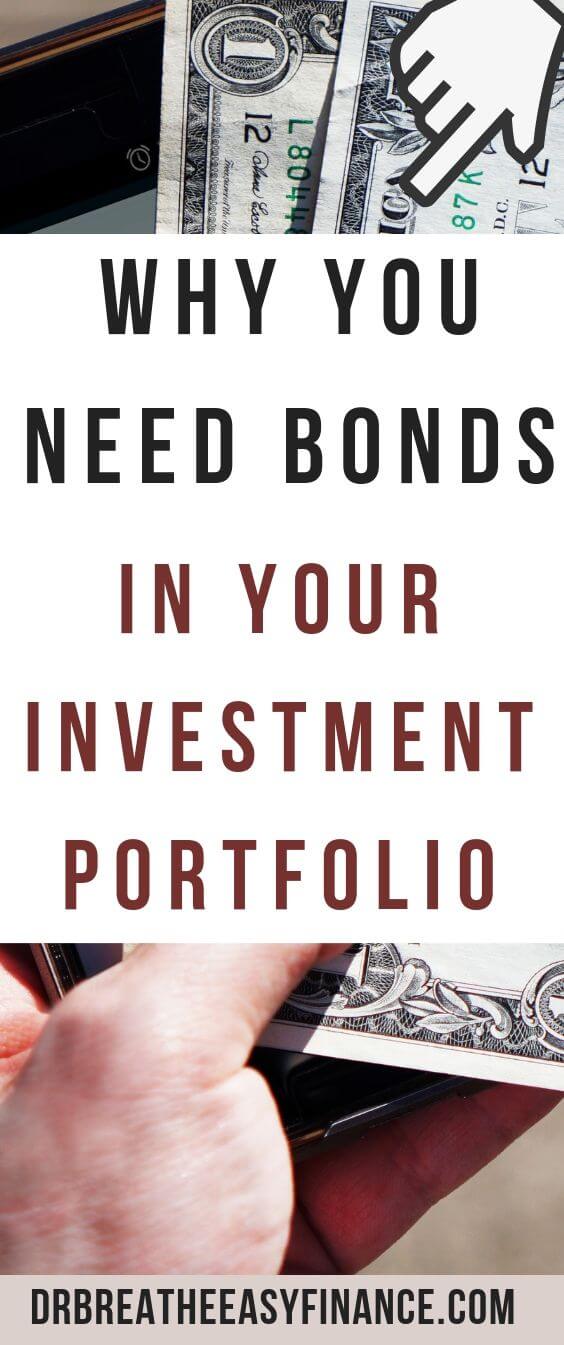
Do I Need Bonds in my Portfolio?
What a great question to ask. The FIRE crowd says “VTSAX and forget it;” but is that right for everyone?
I think not. Everyone needs bonds, at least initially. Let me tell you why.
Recency Bias
Have you ever lost 40% of your portfolio’s value? The market has been on a 10-year run, and most readers of this blog have not experienced the gut-wrenching feeling of losing (at least on paper) a good chunk of your hard-earned money. This is recency bias, where you think the status quo will continue indefinitely.
Remember, the market ALWAYS goes down. Until you know how you are going to react to that fact, think about safety first.
The most important piece of investing (aside from just doing it), is not to sell low. If the market tanks and you panic, you will lose the game of investing. The canoe will tip, and instead of just getting wet, you might sink.
Remember, the market ALWAYS goes down. Until you know how you are going to react to that fact, think about safety first. Share on X
The Game of Investing
Who me? I won’t panic.
These are famous last words. If you’ve never been through a 40% drop in the market, how do you know you won’t panic?
Remember, investing is a game of one. It is you against you. If history is a guide, you will win if you don’t sell out at the worst time, as too many people do.
Investing is not a zero-sum game; everyone can win if you play by the rules. You are participating in the growth of the economy in general: more people, more products, more consumption, and that growth is the return you get from investing.
Paper losses aren’t real; panic selling, however, locks in the loss.
Paper losses aren’t real; panic selling, however, locks in the loss. Share on X
Don’t Sell Low
So, how can you not sell low?
One way: lose the password to your investment account. Seriously. If you have a 401k, for example, set it up how you want it, and then lose your password. Don’t check it for another 1-2 years. There is nothing you want to do in there anyway.
Or cancel cable. Remember, TV’s job is to sell eyeballs advertising, and literally there is nothing important you might learn on TV about investing or the stock market.
Or stop talking to other people about hot stock tips. If a friend mentions bitcoin or blockchain (or Blockbuster), change the subject. Your friend is going to lose money.
You are going to lose your password.
So, How Do You Set It Up?
Bonds are volatility dampeners. That’s it; that’s the secret. They reduce the downside in investing.
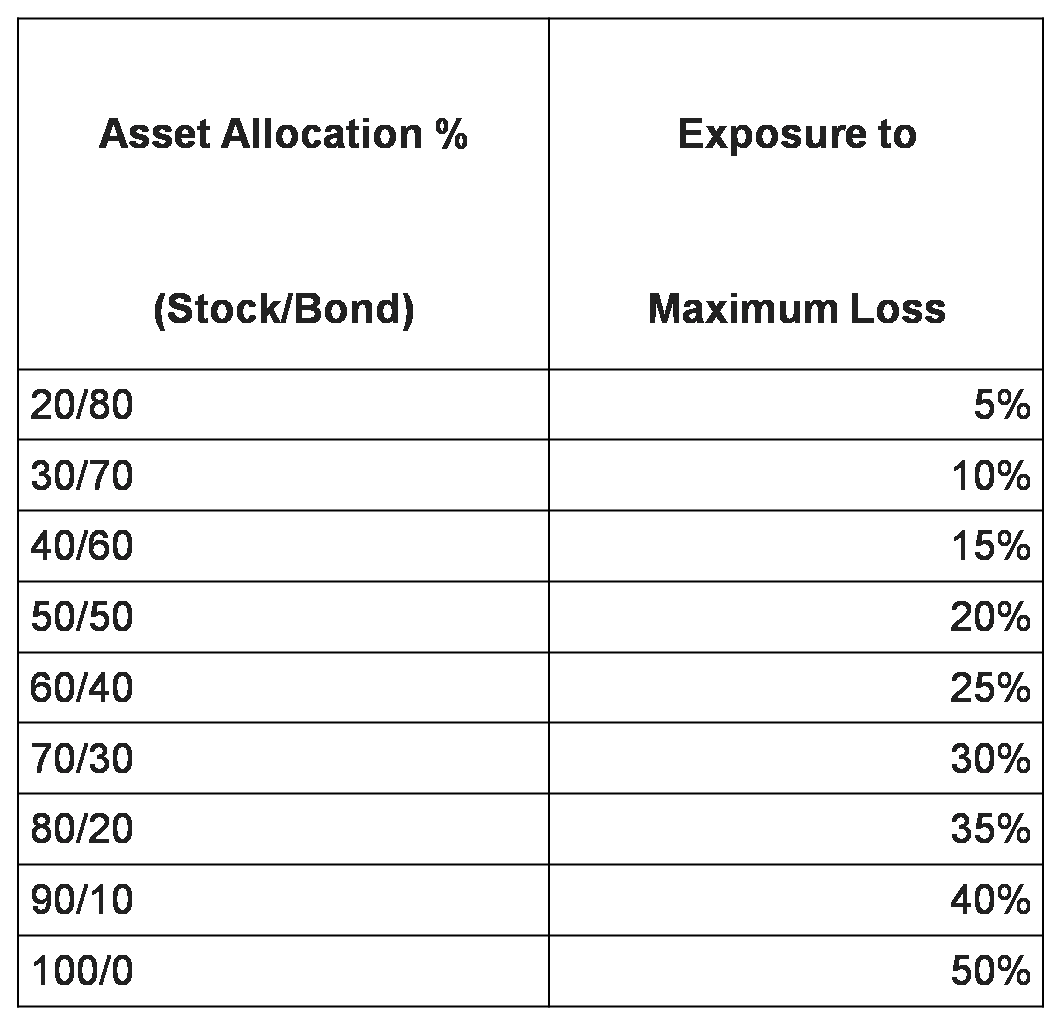
In figure 1 above, we see what effect asset allocation (bond percentage) has on maximum loss. If you are in 100% stocks, you can lose 50%. If you are in a 60/40 portfolio, you lose much less at 25%.
How does this look visually? Let’s look at a decade in recent history, from 2000-2010 (returns are shown in figure 5).
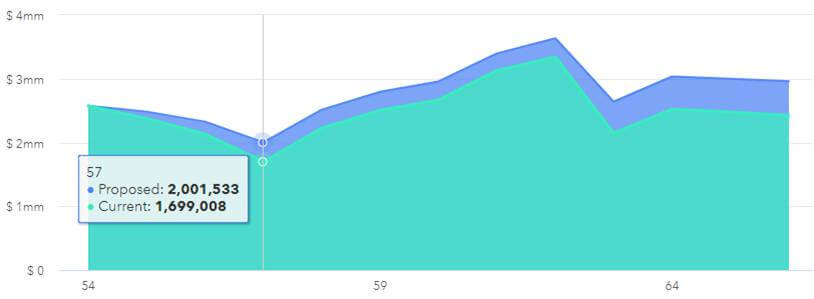
Figure 2 (80/20 portfolio)
Above, see the effects of stock and bond returns on a $2.75 million portfolio in a theoretical 54-year-old investor. The teal color represents 100% stocks. The blue color above is an 80% stocks 20% bonds portfolio.
After the first 3 years of losses, the 100% portfolio has $300,000 less. The next 4 years have pretty good returns, though the 80/20 portfolio keeps its value well. The next big drop is another divergence and as the decade closes, 100% stocks is worth the same as at the start (hence the name “the lost decade”) and the 80/20 portfolio has a positive return.
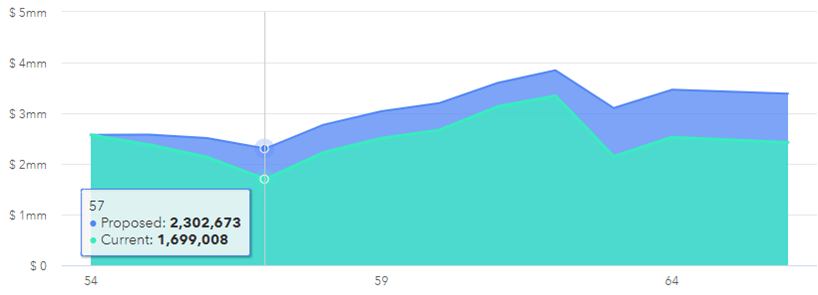
Figure 3(60/40 portfolio)
Let’s look at a 60/40 portfolio next compared again to the 100% stock portfolio. Note the scale is slightly different than the last figure. Now we can really see a difference in the down years, but also see how the 100% stock portfolio starts to make up ground in the 4 good years. The next big drop is seen again, but the 60/40 portfolio winds up with more money than even the 80/20.
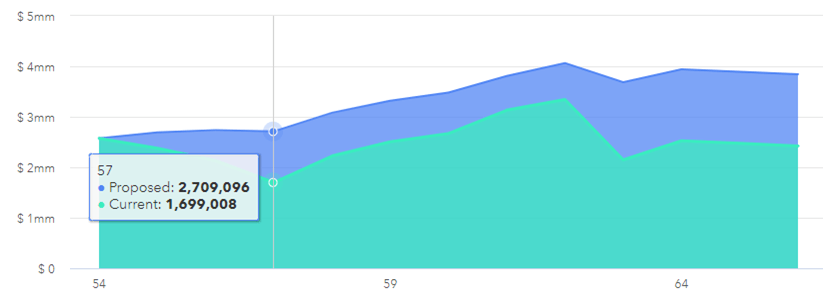
Figure 4 (40/60 portfolio)
Just to make the point, above is a portfolio with 40% stocks and 60% bonds. Note that this very conservative portfolio actually grows during both the initial bad and 4 subsequent years. Below are the returns used for the above scenarios.
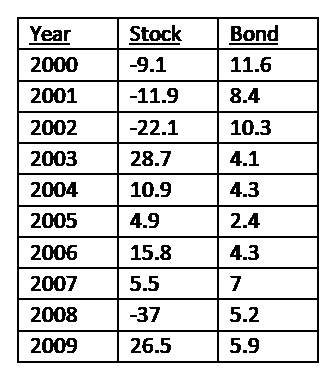
Figure 5 (Stock and Bond returns from 2000-2009)
Risks of bonds
Bonds are generally safe investments. Stick to US Treasuries if you want no risk. Short and intermediate-term bonds decrease the risk due to increasing interest rates. Total bond indexes are often suggested as a part of the three-fund portfolio. If you are in a high tax bracket, consider Municipal bonds in your taxable accounts.
Stay away from “high-yield” bonds, AKA Junk Bonds. Remember, the point of bonds is a dampener of volatility, so don’t go reaching for yield in your bonds (that’s what stocks are for).
If you ever wonder which investment is better – you have to check out the pretax vs after tax article.
Don’t Get Hung Up on Complications
Bonds are complicated. There is duration and convexity, default and interest rate risk, coupon and par…
Stick to what is important. While learning to canoe, wear your personal flotation device. Once you’ve been in the water a few times and decide you can swim—that is once you’ve been through a stock market crash or recession—then see what asset allocation is right for you.
Remember the most important part of early investing: savings rate.
Your investment return doesn’t even mater until you get a good-sized nest egg, so why take the downside risk until you are sure you can tolerate it?
Bonds in your target date fund
One easy way to invest is a target date fund. This type of fund has stocks and bonds in a pre-set ratio depending on your age.
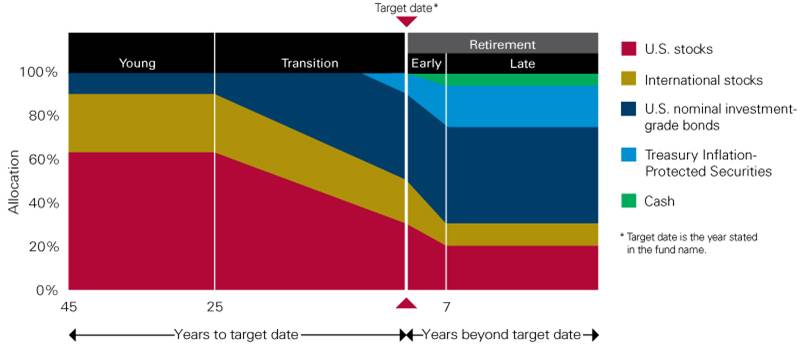
From Vanguard
Above you can see a demonstration of how target-date funds go from a 3-fund portfolio and increase bonds as you get closer to retirement. Note when “young” a 10% bond allocation. Again, this is downside protection.
Summary
Bonds are not sexy, but there is something to be said about the stabilizing effect they have on your portfolio.
When the market is falling apart—If they stop you from selling low—they are worth their weight in gold.
Bonds hedge against making panic decisions.
If you are new to investing and have never been through a big drop in the market, have bonds in your portfolio. If, during the peak of despair, you can ignore the panic on TV and among your friends, then maybe you don’t need bonds.
If your response to a market crash instead is to buy a stock when they are on sale, maybe that is the time to sell your bonds and go all in on stocks. You will be buying low!
Remember, in the beginning, the savings rate is all that matters. Returns on your investment don’t matter until later. Just don’t sell low!
Let us know what you think in the comment section. What type of portfolio do you have? How many percent bond is acceptable to you?

David Graham, MD @ FI Physician
David Graham, MD, is a practicing Infectious Disease physician and blogs at FiPhysician.com. After discovering his passion for personal finance, he started a Registered Investment Advisory to promote his mission of “Financial Literacy for Physicians.” For personal enjoyment, he recently sat for and passed the CFP exam.








Xrayvsn says
Nice analysis once again on how bonds can smooth out the volatility and help investors not panic sell.
I admit that I have personally decreased my allocation of bonds in my portfolio for awhile because of several factors:
1) I feel that I am a very risk tolerant person and not prone to panic sales as I have already been subject to market drops in my investing career and kept putting money in the way I intended.
2) I have created a substantial passive income stream (via real estate mainly but some dividends etc) that when I do retire will give me a floor income level which is more than enough to have a decent lifestyle in the event of a severe drop in stocks (and thus I won’t have to sell depressed assets just to find a minimal lifestyle)
I know it is definitely not the same thing, but I increased my position in REITS which typically have yields far higher than bonds so that that will produce a fairly stable income in retirement. Granted REIT values could take a hit like they did in 2008 but if I am not planning on selling them I won’t have to lock in the losses.
Adebayo says
well said, my friend. For my age at 33, some would say 10% is too small of a bond percentage. I think I have a high-risk tolerance too, however, I am still in the early stage of wealth accumulation. I am slowly building up that passive income stream to be able to have the same piece of mind. What I have working for me, is the long horizon that I have, so I can wait out a downturn. Thanks for stopping by. Your comments are always insightful
Nate Matherson says
Great post!
I didn’t start thinking about adding bonds to my portfolio until this year. I think I did it in a couple interesting ways too. I actually used a portion of my tax return to buy paper treasury bonds. It was cool to get a physical piece of paper in the mail, but like you say still not a cool as stocks. Second, I’ve been using a short term bond fund ETF. Monthly dividends with a 2.5% yield has been great!
Adebayo says
Thanks for stopping by. The debate is still ongoing. I have about 10% bonds at this time but I have contemplated getting rid of bonds myself but I am keeping it for now. 2.5% yield monthly? Thats pretty high!
Gasem says
I’m about 60/35 with 5% in GLD which is actually worth its weight in gold. I aggressively re-balance the 60/35 and bought the GLD cheap. The reason bonds and GLD work to quell volatility is they are true non correlated assets, meaning as the value of stocks plummet or soar the value of bonds stays virtually stable. The above graphs represent the “free money” of non correlated diversity. My habit is to sell stocks bit by bit as they appreciate (sell high approach) by re-balancing to a fixed AA. The sold high value is stored in the non correlated bonds. When the market dives I merely sell bonds which are now relatively high and buy stocks which are low. The market generally goes up more than it crashes so this is a mechanical strategy to market time the crashes and supercharge the recovery. I stress mechanical! no human intervention needed or desired. So what about that pesky GLD? If you look at GLD compared to stocks it generally has a 0 correlation, but in the case of a crash tends to be where people store value and the price rises considerably. A high price gives me something to “sell high” when I want to leave portfolio withdrawal alone. Portfolio withdrawal in down times IS the definition of SORR, better to sell something high and try not to engage in making things worse. If you sell your GLD there will be a time to buy it back cheaply as GLD does not return a dividend so people tend to not own it and the price recedes as the market recovers . It’s why I only own a little
The other way of looking at it is a market crash of 50% stocks means you have to make back 100% to get even and that takes time, In 2009 it was till 2013 until things got even. In the 60/35/5 case the portfolio dropped 25% meaning it took 50% to get back even and that occurred 2 years earlier in 2011 for the less risky portfolio. By 2013the less risky portfolio was making new money for 2 years.
Over the VERY VERY long term likely 100% stocks will win except for the SORR and things like deflation which can kill you dead. IMHO we narrowly missed deflation and turning into Japan in 2009. It can happen. Look at a chart of the Nikkei 225 back around 1970-1990 then 1990 going forward. Imagine you owned the Nikkei. That is the ugly face of deflation.
That’s my risk management scheme
Wealthy Doc says
Heck Yes,
I think Dave Ramsey is crazy to say invest 100% in stocks for everyone.
Bonds “smooth the ride” to quote JL Collins.